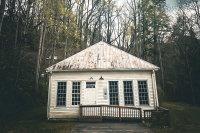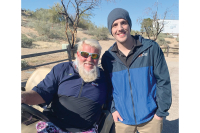Life on LeConte: Winter on the top demonstrates the harshness and beauty of nature
 Sipping hot tea while swaddled beside a propane heater, warmth beaming as wind whips snowflakes around the mountaintop outside. A stack of books beside the bed, well-worn titles alongside new adventures, a self-replenishing treasure trove of stories illuminated by kerosene-fueled light. Outside, darkness obscuring what dawn will reveal to be an ocean-like view of mountains upon mountains, frosted with snow and seeming to bow before the 6,594-foot peak of Mount LeConte, the third highest summit in the Great Smoky Mountains National Park.
Sipping hot tea while swaddled beside a propane heater, warmth beaming as wind whips snowflakes around the mountaintop outside. A stack of books beside the bed, well-worn titles alongside new adventures, a self-replenishing treasure trove of stories illuminated by kerosene-fueled light. Outside, darkness obscuring what dawn will reveal to be an ocean-like view of mountains upon mountains, frosted with snow and seeming to bow before the 6,594-foot peak of Mount LeConte, the third highest summit in the Great Smoky Mountains National Park.
It’s a romantic image, an idyll about which a society steeped in virtual reality is still wont to fanaticize. But for the past four winters, those cozy evenings and frostbitten mornings have been J.P. Krol’s life.
“I did find it was easier to romanticize a little bit when I wasn’t there all the time,” Krol admitted. Spending day after day in the grasp of the mountains fully displays the glory of the outdoors, he said but it also drives home “just how mean nature can be.”
Quiet days
“I relish these quiet days, knowing that the majority of my days in the coming year will be spent exhausting myself both physically and socially. It is an ideal opportunity to recharge mentally, recover physically and enter my next challenge with the proper mindset and appropriate confidence level.”
— Feb. 25, High on LeConte
Related Items
Krol is the winter caretaker at LeConte Lodge, a hike-in-only inn at the top of the mountain. The lodge closes between Thanksgiving and March 10, but someone has to stay around to keep an eye on the buildings, report mountaintop weather to the National Weather Service and just generally maintain a presence at the lodge.
“Somebody has to have a presence there to keep people from being tempted to break in,” said Tim Line, general manager at LeConte and an employee since 1977. “It’s also good to have someone up there to assist the [National] Park Service with rescues. We also have a lot of stuff that can’t freeze, so we need to keep heat on.”
So it’s a necessary position, but not one that includes a multitude of daily tasks. Each day, Krol wakes up around 7 a.m., checks the weather and calls it in to the Park Service’s dispatch center. He makes some coffee, writes something about his adventures from the previous day on the lodge’s blog, “High on LeConte,” and takes some pictures to go with the entry. By 9 a.m., he’s pretty much done with his duties for the day.
Spoiled by adventure
“I get giddy when those first shafts of golden light cut through the thin spruces and set the trail afire … This is where my daily metamorphosis takes place. There is simply no way eloquent enough to measure, to grasp just what these experiences do to me. I am spoiled rotten and simply don’t know how I’d get a fix like this if I didn’t live in the mountains. They have worked themselves into the core of my being and are now an essential component for anything resembling a full life. Reality. Beauty beats bread.”
— Feb. 6, High on LeConte
Originally from upstate New York, Krol studied at Indiana University in Bloomington, Indiana, graduating in 2007 with a degree in philosophy, religion and sociology. He stayed around after graduation, working in the kitchen of a bakery in town. But in 2010, he took off to thru-hike the 2,189-mile Appalachian Trail. He returned when he was done, but life back in Bloomington didn’t go as planned.
“I went back to my small town to have my normal life back, but I realized that wasn’t really going to work for me,” Krol said. You can finish the A.T., but that’s no guarantee that the A.T. is finished with you.
“It kind of messes you up to a degree,” he said.
So, Krol left Bloomington. He found a summer job working on a trail crew in the Green Mountains of Vermont. But as the season’s end loomed, he had to start figuring out what to do next. Krol estimates he filled out 40 applications that fall, hoping to snag one of the limited winter positions available in the world of backcountry professionals.
He got a call back from LeConte and headed down south for his first — and possibly only — season. The job wore better than he’d expected.
“I thought at first maybe I’d do this for one or two years and that would be my time at Walden, so to speak, but now it feels likes I have a lot of friends here and a lot of folks who end up visiting and really enjoy being up here that I really don’t feel like I’m wanting,” he said.
Socializing in solitude
“Yesterday evening my friends and I were treated to one of the best sunsets I’ve seen up here. I’ve jokingly started grading sunsets and knew straight away that this was due to be an A+. Clingmans [Dome] resembled a majestic whale coming up for air and the clear conditions let the orange glow linger long and long … It was another one of those evenings for which the right words just do not exist.”
— Dec. 31, 2014, High on LeConte
Living in a primitive mountain cabin miles from any road isn’t quite the solitary experience one might expect, as it turns out. In the four winters Krol’s lived on LeConte, five days is the longest he’s gone without seeing another human being. For most people, that’s still a pretty long time, but Krol’s domain gets some considerable traffic despite its remoteness and the difficulty of the hike up.
“Everyone who comes up here realizes it’s a burly hike, but if you’re interested in winter hiking in the southeast, this is one of a few places you’re going to go to,” Krol said.
He also gets a steady stream of visitors, probably two weekends out of three, who will come stay in the guest cabin, share some stories, go on a few hikes — and hopefully bring some fresh food to break up the monotony of oatmeal and canned soup. They’re mostly people he hiked the A.T. with, or people he met in his native northeast who happen to be in the area. Krol’s guest cabin has a revolving door.
But there’s plenty of alone time, too, plenty of hours not filled by the duties of a job or the company of a friend. And there’s plenty of inconvenience associated with hauling water up from a spring, making an expedition to the outhouse every time nature calls, walking from cabin to kitchen whenever it’s time for a meal.
“You’ve got to like that lifestyle,” Line said.
Krol does.
“I don’t get to see as much live music as I used to, but it’s a different book or different hike every day, so that’s exciting,” he said. “But as I get older I realize that’s more unusual.”
A need to be inspired
“We are all just visitors here, the plants and bugs and real mammals are the only ones who can truly call such a hostile place home. We need to take this seed of humility and let it flower into reverence, treating these places with the love and respect they deserve.”
— Dec. 23, High on LeConte
Krol turned 30 just a couple weeks ago. He’s still working seasonal, still migrating between New England and the Smokies. For some of the well-meaning dad types he encounters in his work, he said, that’s puzzling. They want to know what he’s doing next, what his “Plan For The Future” is.
Krol doesn’t have a “Plan For The Future.” What he has is a desire to be inspired, to be constantly in discovery. Would he consider getting a year-round job sometime? Sure, but only if it was “in a place that inspired me and it was a job that challenged me in a way I wanted to be challenged.”
For now, these months alone in the woods are that inspiration, that challenge.
“It definitely makes it easier to be in touch with yourself and realize what your wants are versus your needs, just figuring out what works for you,” he said. “I don’t know if that works for everyone, but for me that’s what time in the woods kind of does for me.”
There are fewer options when you’re living alone on a mountaintop. There is no concert to go to, no friend’s house to swing by for dinner. There’s no car in need of an oil change or Walmart where you can drop $100 before even realizing it. There is only the snow, the trees, the views and the little camp with the kitchen, the cabin, a laptop computer and a stack of 40 books to read before the lodge opens up again.
Full-color sparseness
“My chest tightened up and my body shivered, and then a funny thing happened — I adapted. This was not temporary and I’d have to bear it until it broke me. My body was not necessarily cooperating at first, but our wills carry us farther than we assume is possible. We just need to give them more opportunities to unfurl their powers.”
— Jan. 8, High on LeConte
Wintertime on LeConte has a sparseness to it. The verdant landscape of summer is gone, the woods silent. Krol finds bobcat and fox tracks on a regular basis, but the most exciting sighting he’s had in his four winters atop the mountain is a fox, spotted last year. “Most of the animals are smarter than we are,” he said. They hang out at the lower elevations.
Snow cover tends to come and go — barring recent weeks, when there’s been a pretty steady snowpack going — but Krol’s learned the hard way to wear microspikes when hiking to avoid wiping out on hidden patches of ice.
Days are short, and bedtime comes soon after dark. The daily routine stays a lot the same, as do the contents of the pantry.
But to Krol, life at the top is anything but monotonous. Monotony is what he was fleeing when he opted for the seasonal life. For a guy who spends most days alone around a frigid 6,000-foot summit, the idea of “normal” American life sounds dreadfully dull.
He blames that perspective on his A.T. experience.
“Eight hours a day you’re seeing new stimulus,” he said. “To go back to a town and work a steady job, that ends up not doing it for you on some level.”
Outdoors, every day feels different, even if those days involve a rotation of the same trails, the same places. Today the light might paint different colors on the snow than when it reflected off yesterday, and the bright-colored bird that crowns tomorrow’s trail might be absent today. The way clouds race across the sky, the velocity of the wind, undulations of temperature — nothing ever stays the same.
“Every day I’m up here, I notice something,” Krol said.
Which, maybe, is what life on LeConte is all about: the gift of time to notice. The winters are long, nature is harsh and when reality melds with romanticism, the airbrushed façade crumbles. But even the harshness is beautiful, and it’s all-consuming, demanding that the lowly human occupying that tiny cabin notice, reflect and admire.
“I went out for a short jaunt yesterday afternoon, just as the impressively raw weather was cresting. Freezing rain was flying sideways, leaving you to cinch your hood and shake your head at just how real reality can be. We are typically selective with our days in the backcountry, but when we limit ourselves to ‘nice’ days, we miss a great deal. I will remember the cruel winds whipping my face at Cliff Tops and the way the sleet was just solid enough to hurt more than every non-descript sunny day combined. I am the luckiest man alive.”
— Feb. 17, High on LeConte
Follow the adventure
J.P. Krol makes daily posts on the lodge’s blog, www.highonleconte.com/daily-posts. Each post — titled with a lyric from whatever song he’s listening to while he writes — begins with the day’s weather report and then goes into a recap and reflection on the previous day’s adventures, paragraphs interspersed among an ample supply of photos.
Reading list
Krol goes through 30 or 40 books every season, but in his opinion that’s not enough.
“Pretty much about this time every season I look at the big stack of books I didn’t get to,” he said.
Here’s a sampling of what’s stacked in his cabin right now:
- Mary Oliver, various poetry
- Henry Mitchell, Summer Boy and Between Times
- Annie Dillard, various literature
- Gretel Ehrlich, The Solace of Open Spaces
- Diane Ackerman, A Natural History of Love
- American Earth, various authors
A day in the life
- 7 a.m. Wake up.
- 7:15 a.m. Call in the weather report — overnight low, high yesterday, temperature at 7 a.m., sky conditions and snow depth, if any — to the Great Smoky Mountains National Park’s dispatch office.
- 7:30 a.m. Make coffee and start writing the day’s blog post, starring today’s weather report and yesterday’s adventures. Take a few minutes to go outside and snap some photos.
- 9 a.m. Close the computer. Eat breakfast. Decide what kind of day’s it’s going to be — time to hibernate with a book or head outside for a hike?
- Sunset: Eat dinner, usually on a rocking chair sitting on the porch.
- Dark: Go to bed. Spend an hour or so listening to music.
- 8-9 p.m. Go to sleep.
A primer on LeConte Lodge
The lodge got its start in 1925 as a tent camp to entertain dignitaries from Washington, D.C., back when talk of turning the Smokies into a park first started getting serious. Now, the collection of cabins and buildings accommodate an average of 45 visitors a night between March and November. Many people book their rooms a full year in advance.
“Weekends fill up real fast,” said manager Tim Line.
Many inn operators might say the same thing, but LeConte is unique in that no roads lead to it. Getting there requires a strenuous hike of 5 to 8 miles, and the lodge is supplied not by trucks but by a pack of llamas that make the trip three days a week during the season.
The lodge is located in the Great Smoky Mountains National Park but is run by a private company that has a contract with the Park Service. Since 1989, that company has been Stokely Hospitality Enterprises.









